This pipeline computes the correlation between significant copy number variation (cnv focal) genes and selected clinical features.
Testing the association between subtypes identified by 30 different clustering approaches and 8 clinical features across 493 patients, 26 significant findings detected with Q value < 0.25.
-
2 subtypes identified in current cancer cohort by 'Amp Peak 1(1q24.1) mutation analysis'. These subtypes do not correlate to any clinical features.
-
2 subtypes identified in current cancer cohort by 'Amp Peak 2(1q32.1) mutation analysis'. These subtypes do not correlate to any clinical features.
-
2 subtypes identified in current cancer cohort by 'Amp Peak 3(3q26.32) mutation analysis'. These subtypes correlate to 'PATHOLOGY.T', 'PATHOLOGICSPREAD(M)', and 'TUMOR.STAGE'.
-
2 subtypes identified in current cancer cohort by 'Amp Peak 4(4q32.1) mutation analysis'. These subtypes do not correlate to any clinical features.
-
2 subtypes identified in current cancer cohort by 'Amp Peak 5(5q35.1) mutation analysis'. These subtypes do not correlate to any clinical features.
-
2 subtypes identified in current cancer cohort by 'Amp Peak 6(7q36.3) mutation analysis'. These subtypes do not correlate to any clinical features.
-
2 subtypes identified in current cancer cohort by 'Amp Peak 7(8q24.22) mutation analysis'. These subtypes correlate to 'PATHOLOGY.T'.
-
2 subtypes identified in current cancer cohort by 'Amp Peak 8(10p14) mutation analysis'. These subtypes do not correlate to any clinical features.
-
2 subtypes identified in current cancer cohort by 'Amp Peak 9(17q24.3) mutation analysis'. These subtypes do not correlate to any clinical features.
-
2 subtypes identified in current cancer cohort by 'Amp Peak 10(Xp22.2) mutation analysis'. These subtypes do not correlate to any clinical features.
-
2 subtypes identified in current cancer cohort by 'Amp Peak 11(Xp11.4) mutation analysis'. These subtypes do not correlate to any clinical features.
-
2 subtypes identified in current cancer cohort by 'Amp Peak 12(Xq11.2) mutation analysis'. These subtypes do not correlate to any clinical features.
-
2 subtypes identified in current cancer cohort by 'Del Peak 1(1p36.23) mutation analysis'. These subtypes do not correlate to any clinical features.
-
2 subtypes identified in current cancer cohort by 'Del Peak 2(1p31.1) mutation analysis'. These subtypes do not correlate to any clinical features.
-
2 subtypes identified in current cancer cohort by 'Del Peak 3(1q43) mutation analysis'. These subtypes do not correlate to any clinical features.
-
2 subtypes identified in current cancer cohort by 'Del Peak 4(2q37.3) mutation analysis'. These subtypes do not correlate to any clinical features.
-
2 subtypes identified in current cancer cohort by 'Del Peak 5(3p25.3) mutation analysis'. These subtypes do not correlate to any clinical features.
-
2 subtypes identified in current cancer cohort by 'Del Peak 6(3p21.32) mutation analysis'. These subtypes correlate to 'PATHOLOGY.T' and 'TUMOR.STAGE'.
-
2 subtypes identified in current cancer cohort by 'Del Peak 7(3p12.2) mutation analysis'. These subtypes do not correlate to any clinical features.
-
2 subtypes identified in current cancer cohort by 'Del Peak 8(3q11.2) mutation analysis'. These subtypes correlate to 'GENDER'.
-
2 subtypes identified in current cancer cohort by 'Del Peak 9(4q34.3) mutation analysis'. These subtypes correlate to 'Time to Death', 'PATHOLOGY.T', and 'TUMOR.STAGE'.
-
2 subtypes identified in current cancer cohort by 'Del Peak 10(6q26) mutation analysis'. These subtypes do not correlate to any clinical features.
-
2 subtypes identified in current cancer cohort by 'Del Peak 11(6q26) mutation analysis'. These subtypes do not correlate to any clinical features.
-
2 subtypes identified in current cancer cohort by 'Del Peak 12(8p23.2) mutation analysis'. These subtypes do not correlate to any clinical features.
-
2 subtypes identified in current cancer cohort by 'Del Peak 13(9p23) mutation analysis'. These subtypes correlate to 'Time to Death', 'PATHOLOGY.T', 'PATHOLOGICSPREAD(M)', and 'TUMOR.STAGE'.
-
2 subtypes identified in current cancer cohort by 'Del Peak 14(9p21.3) mutation analysis'. These subtypes correlate to 'Time to Death', 'PATHOLOGY.T', 'PATHOLOGICSPREAD(M)', and 'TUMOR.STAGE'.
-
2 subtypes identified in current cancer cohort by 'Del Peak 15(10q23.31) mutation analysis'. These subtypes correlate to 'PATHOLOGY.T'.
-
2 subtypes identified in current cancer cohort by 'Del Peak 16(13q13.3) mutation analysis'. These subtypes correlate to 'Time to Death', 'PATHOLOGY.T', and 'TUMOR.STAGE'.
-
2 subtypes identified in current cancer cohort by 'Del Peak 17(14q31.1) mutation analysis'. These subtypes correlate to 'PATHOLOGY.T', 'PATHOLOGY.N', 'PATHOLOGICSPREAD(M)', and 'TUMOR.STAGE'.
-
2 subtypes identified in current cancer cohort by 'Del Peak 18(Xq23) mutation analysis'. These subtypes do not correlate to any clinical features.
Table 1. Get Full Table Overview of the association between subtypes identified by 30 different clustering approaches and 8 clinical features. Shown in the table are P values (Q values). Thresholded by Q value < 0.25, 26 significant findings detected.
|
Clinical Features |
Time to Death |
AGE | GENDER |
KARNOFSKY PERFORMANCE SCORE |
PATHOLOGY T |
PATHOLOGY N |
PATHOLOGICSPREAD(M) |
TUMOR STAGE |
| Statistical Tests | logrank test | t-test | Fisher's exact test | t-test | Fisher's exact test | Fisher's exact test | Fisher's exact test | Fisher's exact test |
| Amp Peak 1(1q24 1) |
0.2 (1.00) |
0.164 (1.00) |
0.666 (1.00) |
0.499 (1.00) |
0.157 (1.00) |
0.0751 (1.00) |
0.339 (1.00) |
0.298 (1.00) |
| Amp Peak 2(1q32 1) |
0.437 (1.00) |
0.0725 (1.00) |
0.771 (1.00) |
0.499 (1.00) |
0.164 (1.00) |
0.482 (1.00) |
0.703 (1.00) |
0.24 (1.00) |
| Amp Peak 3(3q26 32) |
0.156 (1.00) |
0.903 (1.00) |
0.442 (1.00) |
0.152 (1.00) |
0.000107 (0.0238) |
0.0593 (1.00) |
7.09e-05 (0.0159) |
2.55e-05 (0.00579) |
| Amp Peak 4(4q32 1) |
0.0584 (1.00) |
0.416 (1.00) |
0.258 (1.00) |
0.411 (1.00) |
0.265 (1.00) |
0.574 (1.00) |
0.462 (1.00) |
0.415 (1.00) |
| Amp Peak 5(5q35 1) |
0.0454 (1.00) |
0.0923 (1.00) |
0.141 (1.00) |
0.944 (1.00) |
0.295 (1.00) |
0.31 (1.00) |
0.366 (1.00) |
0.629 (1.00) |
| Amp Peak 6(7q36 3) |
0.724 (1.00) |
0.806 (1.00) |
0.0352 (1.00) |
0.57 (1.00) |
0.0563 (1.00) |
0.443 (1.00) |
0.00523 (1.00) |
0.0202 (1.00) |
| Amp Peak 7(8q24 22) |
0.0527 (1.00) |
0.0214 (1.00) |
0.11 (1.00) |
0.297 (1.00) |
0.00112 (0.237) |
0.74 (1.00) |
0.053 (1.00) |
0.00241 (0.5) |
| Amp Peak 8(10p14) |
0.234 (1.00) |
0.423 (1.00) |
0.594 (1.00) |
0.887 (1.00) |
0.013 (1.00) |
0.188 (1.00) |
0.288 (1.00) |
0.0494 (1.00) |
| Amp Peak 9(17q24 3) |
0.0512 (1.00) |
0.0662 (1.00) |
0.858 (1.00) |
0.471 (1.00) |
0.482 (1.00) |
0.359 (1.00) |
0.244 (1.00) |
0.857 (1.00) |
| Amp Peak 10(Xp22 2) |
0.468 (1.00) |
0.676 (1.00) |
0.854 (1.00) |
0.726 (1.00) |
0.0837 (1.00) |
0.668 (1.00) |
0.0897 (1.00) |
0.0108 (1.00) |
| Amp Peak 11(Xp11 4) |
0.759 (1.00) |
0.712 (1.00) |
0.857 (1.00) |
0.726 (1.00) |
0.0695 (1.00) |
0.668 (1.00) |
0.0509 (1.00) |
0.00533 (1.00) |
| Amp Peak 12(Xq11 2) |
0.803 (1.00) |
0.145 (1.00) |
0.706 (1.00) |
0.726 (1.00) |
0.179 (1.00) |
0.647 (1.00) |
0.31 (1.00) |
0.0584 (1.00) |
| Del Peak 1(1p36 23) |
0.0495 (1.00) |
0.123 (1.00) |
0.123 (1.00) |
0.284 (1.00) |
0.111 (1.00) |
1 (1.00) |
0.0844 (1.00) |
0.168 (1.00) |
| Del Peak 2(1p31 1) |
0.219 (1.00) |
0.0726 (1.00) |
0.016 (1.00) |
0.284 (1.00) |
0.0536 (1.00) |
0.722 (1.00) |
0.294 (1.00) |
0.181 (1.00) |
| Del Peak 3(1q43) |
0.704 (1.00) |
0.335 (1.00) |
1 (1.00) |
0.0712 (1.00) |
0.374 (1.00) |
1 (1.00) |
0.749 (1.00) |
|
| Del Peak 4(2q37 3) |
0.673 (1.00) |
0.63 (1.00) |
0.153 (1.00) |
0.822 (1.00) |
1 (1.00) |
0.402 (1.00) |
0.556 (1.00) |
|
| Del Peak 5(3p25 3) |
0.783 (1.00) |
0.788 (1.00) |
0.569 (1.00) |
0.0817 (1.00) |
0.00144 (0.303) |
1 (1.00) |
0.707 (1.00) |
0.0129 (1.00) |
| Del Peak 6(3p21 32) |
0.498 (1.00) |
0.704 (1.00) |
0.772 (1.00) |
0.0817 (1.00) |
3.34e-05 (0.00756) |
1 (1.00) |
0.333 (1.00) |
0.00053 (0.115) |
| Del Peak 7(3p12 2) |
0.614 (1.00) |
0.761 (1.00) |
0.00221 (0.461) |
0.741 (1.00) |
0.217 (1.00) |
0.626 (1.00) |
0.53 (1.00) |
0.231 (1.00) |
| Del Peak 8(3q11 2) |
0.635 (1.00) |
0.0111 (1.00) |
1.32e-07 (3.1e-05) |
0.749 (1.00) |
0.134 (1.00) |
0.787 (1.00) |
0.591 (1.00) |
0.45 (1.00) |
| Del Peak 9(4q34 3) |
0.000557 (0.12) |
0.568 (1.00) |
0.433 (1.00) |
0.0261 (1.00) |
4.27e-07 (9.98e-05) |
1 (1.00) |
0.00862 (1.00) |
2.7e-06 (0.000626) |
| Del Peak 10(6q26) |
0.565 (1.00) |
0.287 (1.00) |
0.012 (1.00) |
0.256 (1.00) |
0.621 (1.00) |
0.0195 (1.00) |
0.41 (1.00) |
0.32 (1.00) |
| Del Peak 11(6q26) |
0.589 (1.00) |
0.226 (1.00) |
0.00648 (1.00) |
0.256 (1.00) |
0.621 (1.00) |
0.0195 (1.00) |
0.41 (1.00) |
0.32 (1.00) |
| Del Peak 12(8p23 2) |
0.0385 (1.00) |
0.139 (1.00) |
0.256 (1.00) |
0.893 (1.00) |
0.176 (1.00) |
0.786 (1.00) |
0.055 (1.00) |
0.14 (1.00) |
| Del Peak 13(9p23) |
0.000138 (0.0304) |
0.0136 (1.00) |
0.00361 (0.744) |
0.656 (1.00) |
1.39e-05 (0.0032) |
0.262 (1.00) |
0.000876 (0.187) |
5.62e-06 (0.0013) |
| Del Peak 14(9p21 3) |
2.03e-06 (0.000473) |
0.0261 (1.00) |
0.00144 (0.303) |
0.656 (1.00) |
1.01e-07 (2.4e-05) |
0.0589 (1.00) |
6.93e-05 (0.0156) |
3.39e-08 (8.03e-06) |
| Del Peak 15(10q23 31) |
0.217 (1.00) |
0.209 (1.00) |
0.0272 (1.00) |
0.764 (1.00) |
0.000477 (0.104) |
1 (1.00) |
0.333 (1.00) |
0.0177 (1.00) |
| Del Peak 16(13q13 3) |
0.000848 (0.182) |
0.884 (1.00) |
0.794 (1.00) |
0.748 (1.00) |
1.48e-05 (0.0034) |
0.325 (1.00) |
0.0377 (1.00) |
0.000348 (0.0762) |
| Del Peak 17(14q31 1) |
0.00179 (0.374) |
0.055 (1.00) |
0.393 (1.00) |
0.0872 (1.00) |
0.000107 (0.0238) |
0.000113 (0.0249) |
0.00101 (0.216) |
2.42e-05 (0.00553) |
| Del Peak 18(Xq23) |
0.287 (1.00) |
0.669 (1.00) |
0.234 (1.00) |
0.297 (1.00) |
0.657 (1.00) |
0.168 (1.00) |
0.142 (1.00) |
Table S1. Description of clustering approach #1: 'Amp Peak 1(1q24.1) mutation analysis'
| Cluster Labels | AMP PEAK 1(1Q24.1) MUTATED | AMP PEAK 1(1Q24.1) WILD-TYPE |
|---|---|---|
| Number of samples | 60 | 433 |
Table S2. Description of clustering approach #2: 'Amp Peak 2(1q32.1) mutation analysis'
| Cluster Labels | AMP PEAK 2(1Q32.1) MUTATED | AMP PEAK 2(1Q32.1) WILD-TYPE |
|---|---|---|
| Number of samples | 59 | 434 |
Table S3. Description of clustering approach #3: 'Amp Peak 3(3q26.32) mutation analysis'
| Cluster Labels | AMP PEAK 3(3Q26.32) MUTATED | AMP PEAK 3(3Q26.32) WILD-TYPE |
|---|---|---|
| Number of samples | 80 | 413 |
P value = 0.000107 (Fisher's exact test), Q value = 0.024
Table S4. Clustering Approach #3: 'Amp Peak 3(3q26.32) mutation analysis' versus Clinical Feature #5: 'PATHOLOGY.T'
| nPatients | T1 | T2 | T3 | T4 |
|---|---|---|---|---|
| ALL | 242 | 64 | 176 | 11 |
| AMP PEAK 3(3Q26.32) MUTATED | 24 | 8 | 44 | 4 |
| AMP PEAK 3(3Q26.32) WILD-TYPE | 218 | 56 | 132 | 7 |
Figure S1. Get High-res Image Clustering Approach #3: 'Amp Peak 3(3q26.32) mutation analysis' versus Clinical Feature #5: 'PATHOLOGY.T'

P value = 7.09e-05 (Fisher's exact test), Q value = 0.016
Table S5. Clustering Approach #3: 'Amp Peak 3(3q26.32) mutation analysis' versus Clinical Feature #7: 'PATHOLOGICSPREAD(M)'
| nPatients | M0 | M1 |
|---|---|---|
| ALL | 417 | 76 |
| AMP PEAK 3(3Q26.32) MUTATED | 55 | 25 |
| AMP PEAK 3(3Q26.32) WILD-TYPE | 362 | 51 |
Figure S2. Get High-res Image Clustering Approach #3: 'Amp Peak 3(3q26.32) mutation analysis' versus Clinical Feature #7: 'PATHOLOGICSPREAD(M)'
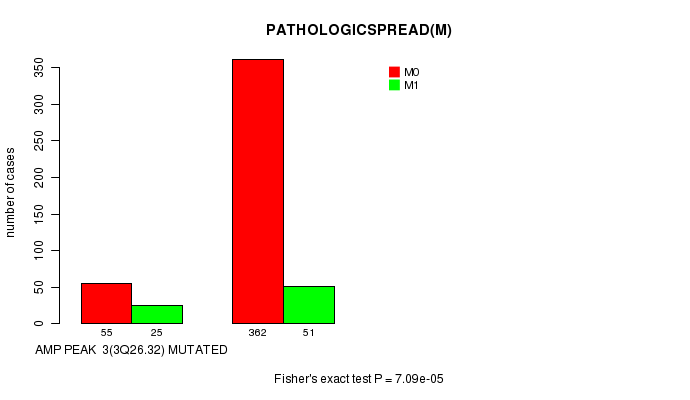
P value = 2.55e-05 (Fisher's exact test), Q value = 0.0058
Table S6. Clustering Approach #3: 'Amp Peak 3(3q26.32) mutation analysis' versus Clinical Feature #8: 'TUMOR.STAGE'
| nPatients | I | II | III | IV |
|---|---|---|---|---|
| ALL | 238 | 52 | 123 | 80 |
| AMP PEAK 3(3Q26.32) MUTATED | 23 | 6 | 25 | 26 |
| AMP PEAK 3(3Q26.32) WILD-TYPE | 215 | 46 | 98 | 54 |
Figure S3. Get High-res Image Clustering Approach #3: 'Amp Peak 3(3q26.32) mutation analysis' versus Clinical Feature #8: 'TUMOR.STAGE'

Table S7. Description of clustering approach #4: 'Amp Peak 4(4q32.1) mutation analysis'
| Cluster Labels | AMP PEAK 4(4Q32.1) MUTATED | AMP PEAK 4(4Q32.1) WILD-TYPE |
|---|---|---|
| Number of samples | 14 | 479 |
Table S8. Description of clustering approach #5: 'Amp Peak 5(5q35.1) mutation analysis'
| Cluster Labels | AMP PEAK 5(5Q35.1) MUTATED | AMP PEAK 5(5Q35.1) WILD-TYPE |
|---|---|---|
| Number of samples | 311 | 182 |
Table S9. Description of clustering approach #6: 'Amp Peak 6(7q36.3) mutation analysis'
| Cluster Labels | AMP PEAK 6(7Q36.3) MUTATED | AMP PEAK 6(7Q36.3) WILD-TYPE |
|---|---|---|
| Number of samples | 163 | 330 |
Table S10. Description of clustering approach #7: 'Amp Peak 7(8q24.22) mutation analysis'
| Cluster Labels | AMP PEAK 7(8Q24.22) MUTATED | AMP PEAK 7(8Q24.22) WILD-TYPE |
|---|---|---|
| Number of samples | 73 | 420 |
P value = 0.00112 (Fisher's exact test), Q value = 0.24
Table S11. Clustering Approach #7: 'Amp Peak 7(8q24.22) mutation analysis' versus Clinical Feature #5: 'PATHOLOGY.T'
| nPatients | T1 | T2 | T3 | T4 |
|---|---|---|---|---|
| ALL | 242 | 64 | 176 | 11 |
| AMP PEAK 7(8Q24.22) MUTATED | 21 | 11 | 39 | 2 |
| AMP PEAK 7(8Q24.22) WILD-TYPE | 221 | 53 | 137 | 9 |
Figure S4. Get High-res Image Clustering Approach #7: 'Amp Peak 7(8q24.22) mutation analysis' versus Clinical Feature #5: 'PATHOLOGY.T'

Table S12. Description of clustering approach #8: 'Amp Peak 8(10p14) mutation analysis'
| Cluster Labels | AMP PEAK 8(10P14) MUTATED | AMP PEAK 8(10P14) WILD-TYPE |
|---|---|---|
| Number of samples | 16 | 477 |
Table S13. Description of clustering approach #9: 'Amp Peak 9(17q24.3) mutation analysis'
| Cluster Labels | AMP PEAK 9(17Q24.3) MUTATED | AMP PEAK 9(17Q24.3) WILD-TYPE |
|---|---|---|
| Number of samples | 37 | 456 |
Table S14. Description of clustering approach #10: 'Amp Peak 10(Xp22.2) mutation analysis'
| Cluster Labels | AMP PEAK 10(XP22.2) MUTATED | AMP PEAK 10(XP22.2) WILD-TYPE |
|---|---|---|
| Number of samples | 35 | 458 |
Table S15. Description of clustering approach #11: 'Amp Peak 11(Xp11.4) mutation analysis'
| Cluster Labels | AMP PEAK 11(XP11.4) MUTATED | AMP PEAK 11(XP11.4) WILD-TYPE |
|---|---|---|
| Number of samples | 36 | 457 |
Table S16. Description of clustering approach #12: 'Amp Peak 12(Xq11.2) mutation analysis'
| Cluster Labels | AMP PEAK 12(XQ11.2) MUTATED | AMP PEAK 12(XQ11.2) WILD-TYPE |
|---|---|---|
| Number of samples | 32 | 461 |
Table S17. Description of clustering approach #13: 'Del Peak 1(1p36.23) mutation analysis'
| Cluster Labels | DEL PEAK 1(1P36.23) MUTATED | DEL PEAK 1(1P36.23) WILD-TYPE |
|---|---|---|
| Number of samples | 98 | 395 |
Table S18. Description of clustering approach #14: 'Del Peak 2(1p31.1) mutation analysis'
| Cluster Labels | DEL PEAK 2(1P31.1) MUTATED | DEL PEAK 2(1P31.1) WILD-TYPE |
|---|---|---|
| Number of samples | 72 | 421 |
Table S19. Description of clustering approach #15: 'Del Peak 3(1q43) mutation analysis'
| Cluster Labels | DEL PEAK 3(1Q43) MUTATED | DEL PEAK 3(1Q43) WILD-TYPE |
|---|---|---|
| Number of samples | 38 | 455 |
Table S20. Description of clustering approach #16: 'Del Peak 4(2q37.3) mutation analysis'
| Cluster Labels | DEL PEAK 4(2Q37.3) MUTATED | DEL PEAK 4(2Q37.3) WILD-TYPE |
|---|---|---|
| Number of samples | 48 | 445 |
Table S21. Description of clustering approach #17: 'Del Peak 5(3p25.3) mutation analysis'
| Cluster Labels | DEL PEAK 5(3P25.3) MUTATED | DEL PEAK 5(3P25.3) WILD-TYPE |
|---|---|---|
| Number of samples | 432 | 61 |
Table S22. Description of clustering approach #18: 'Del Peak 6(3p21.32) mutation analysis'
| Cluster Labels | DEL PEAK 6(3P21.32) MUTATED | DEL PEAK 6(3P21.32) WILD-TYPE |
|---|---|---|
| Number of samples | 435 | 58 |
P value = 3.34e-05 (Fisher's exact test), Q value = 0.0076
Table S23. Clustering Approach #18: 'Del Peak 6(3p21.32) mutation analysis' versus Clinical Feature #5: 'PATHOLOGY.T'
| nPatients | T1 | T2 | T3 | T4 |
|---|---|---|---|---|
| ALL | 242 | 64 | 176 | 11 |
| DEL PEAK 6(3P21.32) MUTATED | 209 | 52 | 168 | 6 |
| DEL PEAK 6(3P21.32) WILD-TYPE | 33 | 12 | 8 | 5 |
Figure S5. Get High-res Image Clustering Approach #18: 'Del Peak 6(3p21.32) mutation analysis' versus Clinical Feature #5: 'PATHOLOGY.T'
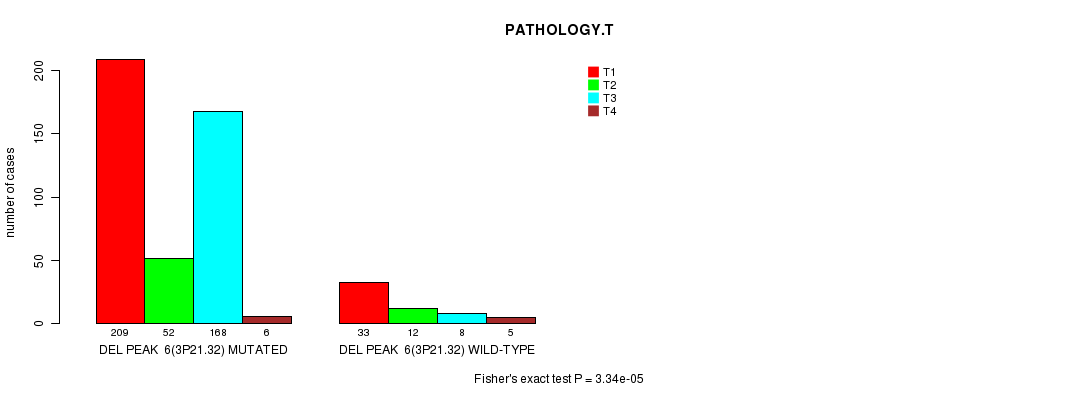
P value = 0.00053 (Fisher's exact test), Q value = 0.12
Table S24. Clustering Approach #18: 'Del Peak 6(3p21.32) mutation analysis' versus Clinical Feature #8: 'TUMOR.STAGE'
| nPatients | I | II | III | IV |
|---|---|---|---|---|
| ALL | 238 | 52 | 123 | 80 |
| DEL PEAK 6(3P21.32) MUTATED | 205 | 40 | 119 | 71 |
| DEL PEAK 6(3P21.32) WILD-TYPE | 33 | 12 | 4 | 9 |
Figure S6. Get High-res Image Clustering Approach #18: 'Del Peak 6(3p21.32) mutation analysis' versus Clinical Feature #8: 'TUMOR.STAGE'
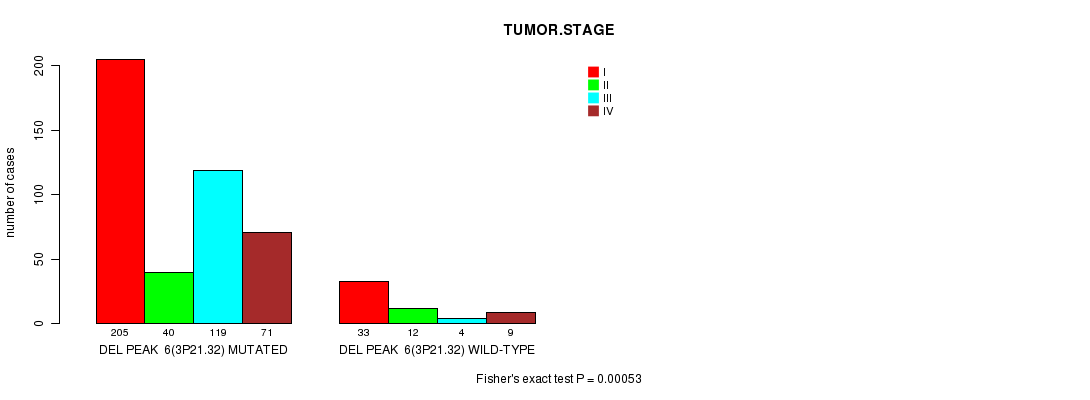
Table S25. Description of clustering approach #19: 'Del Peak 7(3p12.2) mutation analysis'
| Cluster Labels | DEL PEAK 7(3P12.2) MUTATED | DEL PEAK 7(3P12.2) WILD-TYPE |
|---|---|---|
| Number of samples | 283 | 210 |
Table S26. Description of clustering approach #20: 'Del Peak 8(3q11.2) mutation analysis'
| Cluster Labels | DEL PEAK 8(3Q11.2) MUTATED | DEL PEAK 8(3Q11.2) WILD-TYPE |
|---|---|---|
| Number of samples | 150 | 343 |
P value = 1.32e-07 (Fisher's exact test), Q value = 3.1e-05
Table S27. Clustering Approach #20: 'Del Peak 8(3q11.2) mutation analysis' versus Clinical Feature #3: 'GENDER'
| nPatients | FEMALE | MALE |
|---|---|---|
| ALL | 171 | 322 |
| DEL PEAK 8(3Q11.2) MUTATED | 27 | 123 |
| DEL PEAK 8(3Q11.2) WILD-TYPE | 144 | 199 |
Figure S7. Get High-res Image Clustering Approach #20: 'Del Peak 8(3q11.2) mutation analysis' versus Clinical Feature #3: 'GENDER'

Table S28. Description of clustering approach #21: 'Del Peak 9(4q34.3) mutation analysis'
| Cluster Labels | DEL PEAK 9(4Q34.3) MUTATED | DEL PEAK 9(4Q34.3) WILD-TYPE |
|---|---|---|
| Number of samples | 76 | 417 |
P value = 0.000557 (logrank test), Q value = 0.12
Table S29. Clustering Approach #21: 'Del Peak 9(4q34.3) mutation analysis' versus Clinical Feature #1: 'Time to Death'
| nPatients | nDeath | Duration Range (Median), Month | |
|---|---|---|---|
| ALL | 490 | 158 | 0.1 - 111.0 (35.2) |
| DEL PEAK 9(4Q34.3) MUTATED | 76 | 38 | 0.2 - 91.4 (35.1) |
| DEL PEAK 9(4Q34.3) WILD-TYPE | 414 | 120 | 0.1 - 111.0 (35.2) |
Figure S8. Get High-res Image Clustering Approach #21: 'Del Peak 9(4q34.3) mutation analysis' versus Clinical Feature #1: 'Time to Death'
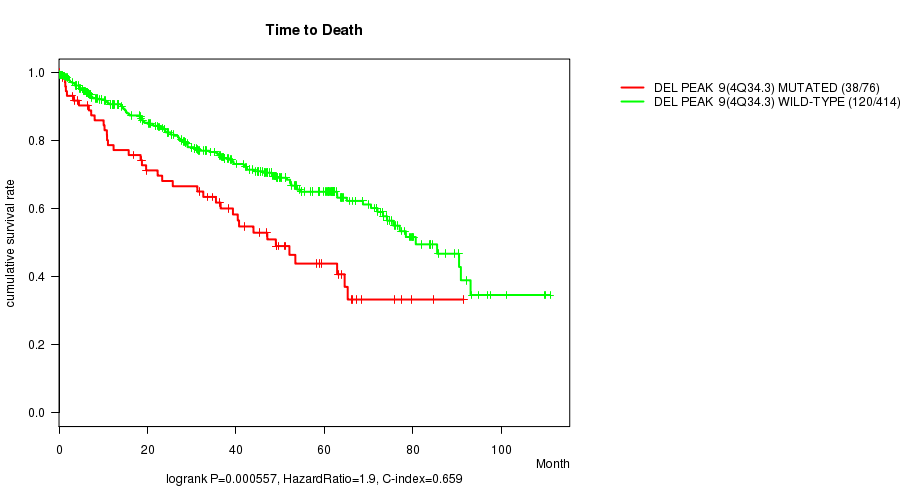
P value = 4.27e-07 (Fisher's exact test), Q value = 1e-04
Table S30. Clustering Approach #21: 'Del Peak 9(4q34.3) mutation analysis' versus Clinical Feature #5: 'PATHOLOGY.T'
| nPatients | T1 | T2 | T3 | T4 |
|---|---|---|---|---|
| ALL | 242 | 64 | 176 | 11 |
| DEL PEAK 9(4Q34.3) MUTATED | 19 | 8 | 43 | 6 |
| DEL PEAK 9(4Q34.3) WILD-TYPE | 223 | 56 | 133 | 5 |
Figure S9. Get High-res Image Clustering Approach #21: 'Del Peak 9(4q34.3) mutation analysis' versus Clinical Feature #5: 'PATHOLOGY.T'
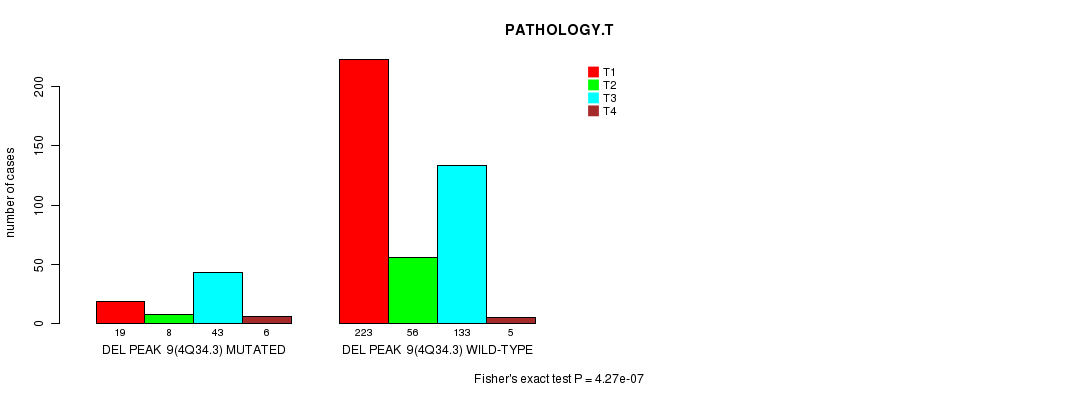
P value = 2.7e-06 (Fisher's exact test), Q value = 0.00063
Table S31. Clustering Approach #21: 'Del Peak 9(4q34.3) mutation analysis' versus Clinical Feature #8: 'TUMOR.STAGE'
| nPatients | I | II | III | IV |
|---|---|---|---|---|
| ALL | 238 | 52 | 123 | 80 |
| DEL PEAK 9(4Q34.3) MUTATED | 18 | 6 | 30 | 22 |
| DEL PEAK 9(4Q34.3) WILD-TYPE | 220 | 46 | 93 | 58 |
Figure S10. Get High-res Image Clustering Approach #21: 'Del Peak 9(4q34.3) mutation analysis' versus Clinical Feature #8: 'TUMOR.STAGE'
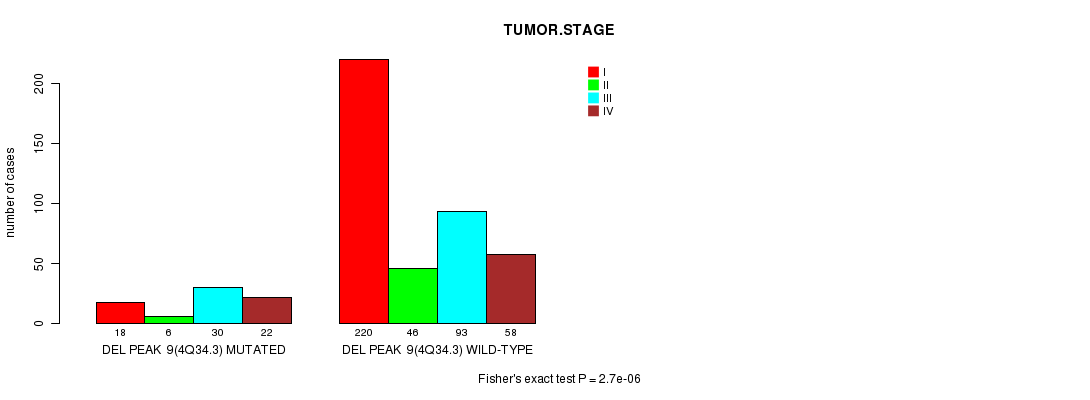
Table S32. Description of clustering approach #22: 'Del Peak 10(6q26) mutation analysis'
| Cluster Labels | DEL PEAK 10(6Q26) MUTATED | DEL PEAK 10(6Q26) WILD-TYPE |
|---|---|---|
| Number of samples | 142 | 351 |
Table S33. Description of clustering approach #23: 'Del Peak 11(6q26) mutation analysis'
| Cluster Labels | DEL PEAK 11(6Q26) MUTATED | DEL PEAK 11(6Q26) WILD-TYPE |
|---|---|---|
| Number of samples | 142 | 351 |
Table S34. Description of clustering approach #24: 'Del Peak 12(8p23.2) mutation analysis'
| Cluster Labels | DEL PEAK 12(8P23.2) MUTATED | DEL PEAK 12(8P23.2) WILD-TYPE |
|---|---|---|
| Number of samples | 146 | 347 |
Table S35. Description of clustering approach #25: 'Del Peak 13(9p23) mutation analysis'
| Cluster Labels | DEL PEAK 13(9P23) MUTATED | DEL PEAK 13(9P23) WILD-TYPE |
|---|---|---|
| Number of samples | 144 | 349 |
P value = 0.000138 (logrank test), Q value = 0.03
Table S36. Clustering Approach #25: 'Del Peak 13(9p23) mutation analysis' versus Clinical Feature #1: 'Time to Death'
| nPatients | nDeath | Duration Range (Median), Month | |
|---|---|---|---|
| ALL | 490 | 158 | 0.1 - 111.0 (35.2) |
| DEL PEAK 13(9P23) MUTATED | 143 | 65 | 0.2 - 109.9 (36.1) |
| DEL PEAK 13(9P23) WILD-TYPE | 347 | 93 | 0.1 - 111.0 (34.6) |
Figure S11. Get High-res Image Clustering Approach #25: 'Del Peak 13(9p23) mutation analysis' versus Clinical Feature #1: 'Time to Death'

P value = 1.39e-05 (Fisher's exact test), Q value = 0.0032
Table S37. Clustering Approach #25: 'Del Peak 13(9p23) mutation analysis' versus Clinical Feature #5: 'PATHOLOGY.T'
| nPatients | T1 | T2 | T3 | T4 |
|---|---|---|---|---|
| ALL | 242 | 64 | 176 | 11 |
| DEL PEAK 13(9P23) MUTATED | 50 | 15 | 74 | 5 |
| DEL PEAK 13(9P23) WILD-TYPE | 192 | 49 | 102 | 6 |
Figure S12. Get High-res Image Clustering Approach #25: 'Del Peak 13(9p23) mutation analysis' versus Clinical Feature #5: 'PATHOLOGY.T'
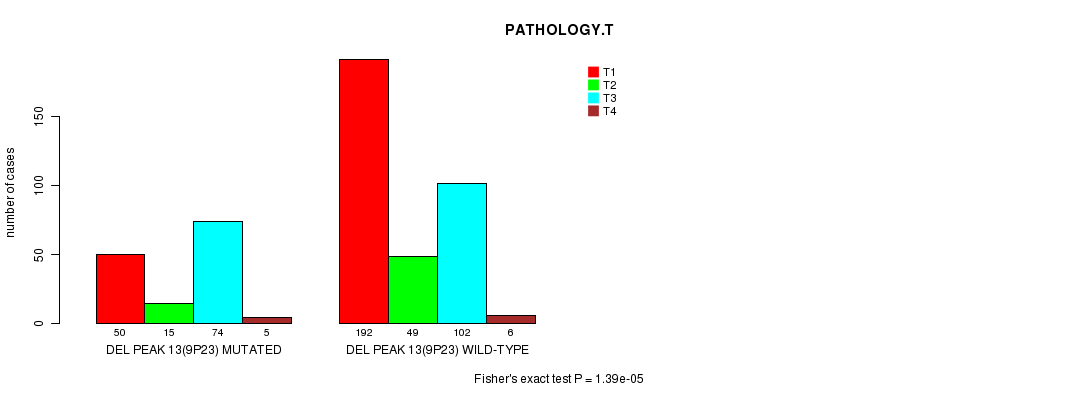
P value = 0.000876 (Fisher's exact test), Q value = 0.19
Table S38. Clustering Approach #25: 'Del Peak 13(9p23) mutation analysis' versus Clinical Feature #7: 'PATHOLOGICSPREAD(M)'
| nPatients | M0 | M1 |
|---|---|---|
| ALL | 417 | 76 |
| DEL PEAK 13(9P23) MUTATED | 109 | 35 |
| DEL PEAK 13(9P23) WILD-TYPE | 308 | 41 |
Figure S13. Get High-res Image Clustering Approach #25: 'Del Peak 13(9p23) mutation analysis' versus Clinical Feature #7: 'PATHOLOGICSPREAD(M)'
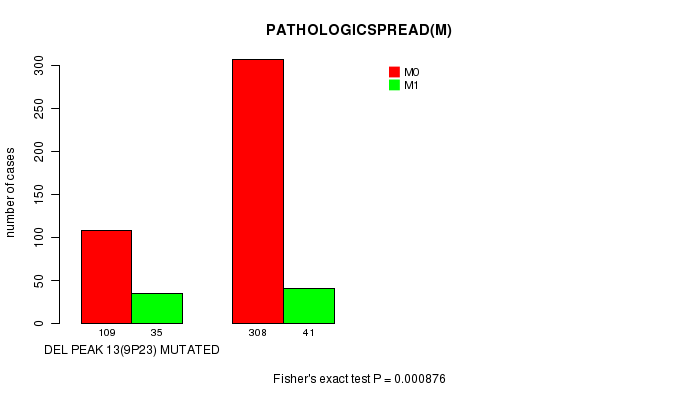
P value = 5.62e-06 (Fisher's exact test), Q value = 0.0013
Table S39. Clustering Approach #25: 'Del Peak 13(9p23) mutation analysis' versus Clinical Feature #8: 'TUMOR.STAGE'
| nPatients | I | II | III | IV |
|---|---|---|---|---|
| ALL | 238 | 52 | 123 | 80 |
| DEL PEAK 13(9P23) MUTATED | 48 | 11 | 49 | 36 |
| DEL PEAK 13(9P23) WILD-TYPE | 190 | 41 | 74 | 44 |
Figure S14. Get High-res Image Clustering Approach #25: 'Del Peak 13(9p23) mutation analysis' versus Clinical Feature #8: 'TUMOR.STAGE'
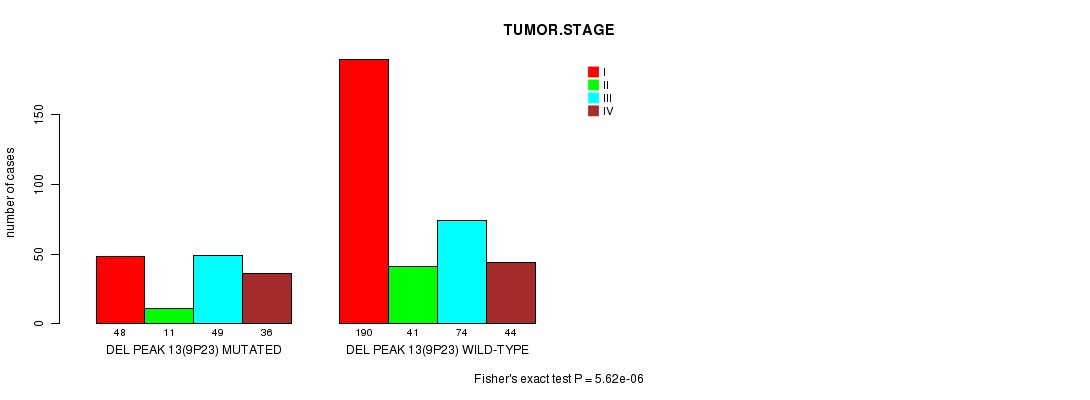
Table S40. Description of clustering approach #26: 'Del Peak 14(9p21.3) mutation analysis'
| Cluster Labels | DEL PEAK 14(9P21.3) MUTATED | DEL PEAK 14(9P21.3) WILD-TYPE |
|---|---|---|
| Number of samples | 152 | 341 |
P value = 2.03e-06 (logrank test), Q value = 0.00047
Table S41. Clustering Approach #26: 'Del Peak 14(9p21.3) mutation analysis' versus Clinical Feature #1: 'Time to Death'
| nPatients | nDeath | Duration Range (Median), Month | |
|---|---|---|---|
| ALL | 490 | 158 | 0.1 - 111.0 (35.2) |
| DEL PEAK 14(9P21.3) MUTATED | 152 | 72 | 0.2 - 109.9 (31.5) |
| DEL PEAK 14(9P21.3) WILD-TYPE | 338 | 86 | 0.1 - 111.0 (36.2) |
Figure S15. Get High-res Image Clustering Approach #26: 'Del Peak 14(9p21.3) mutation analysis' versus Clinical Feature #1: 'Time to Death'
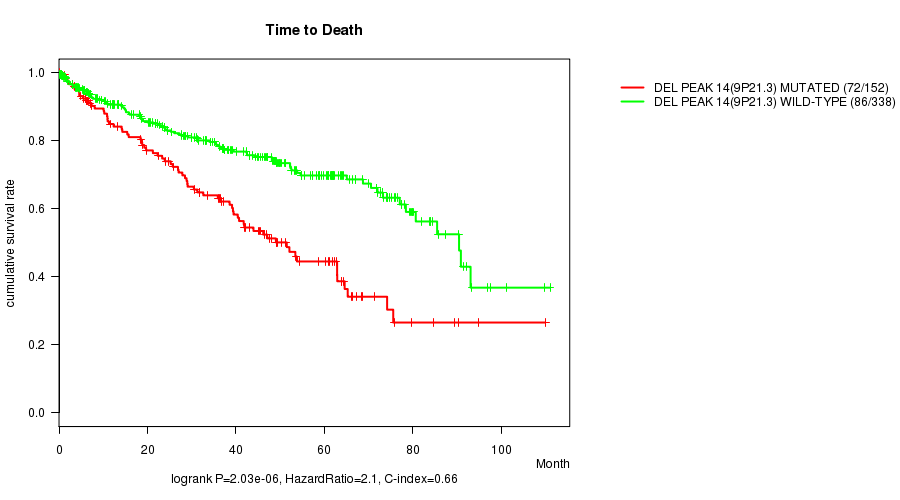
P value = 1.01e-07 (Fisher's exact test), Q value = 2.4e-05
Table S42. Clustering Approach #26: 'Del Peak 14(9p21.3) mutation analysis' versus Clinical Feature #5: 'PATHOLOGY.T'
| nPatients | T1 | T2 | T3 | T4 |
|---|---|---|---|---|
| ALL | 242 | 64 | 176 | 11 |
| DEL PEAK 14(9P21.3) MUTATED | 51 | 14 | 81 | 6 |
| DEL PEAK 14(9P21.3) WILD-TYPE | 191 | 50 | 95 | 5 |
Figure S16. Get High-res Image Clustering Approach #26: 'Del Peak 14(9p21.3) mutation analysis' versus Clinical Feature #5: 'PATHOLOGY.T'
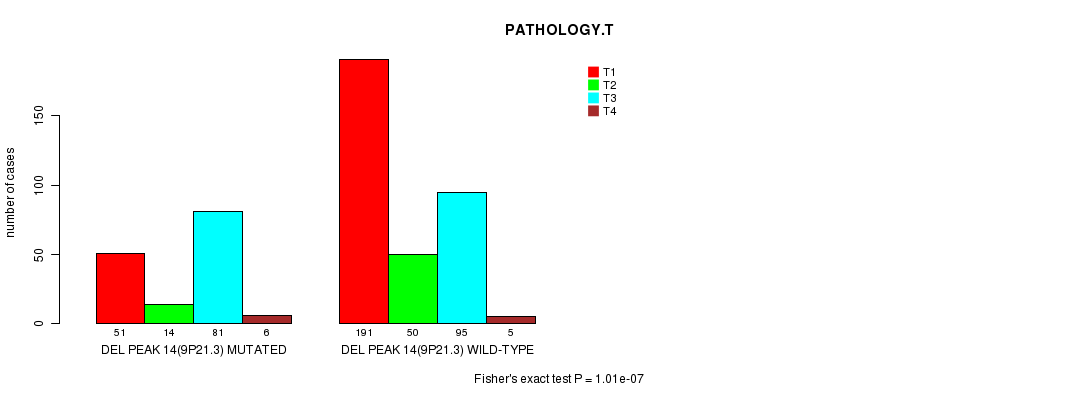
P value = 6.93e-05 (Fisher's exact test), Q value = 0.016
Table S43. Clustering Approach #26: 'Del Peak 14(9p21.3) mutation analysis' versus Clinical Feature #7: 'PATHOLOGICSPREAD(M)'
| nPatients | M0 | M1 |
|---|---|---|
| ALL | 417 | 76 |
| DEL PEAK 14(9P21.3) MUTATED | 113 | 39 |
| DEL PEAK 14(9P21.3) WILD-TYPE | 304 | 37 |
Figure S17. Get High-res Image Clustering Approach #26: 'Del Peak 14(9p21.3) mutation analysis' versus Clinical Feature #7: 'PATHOLOGICSPREAD(M)'
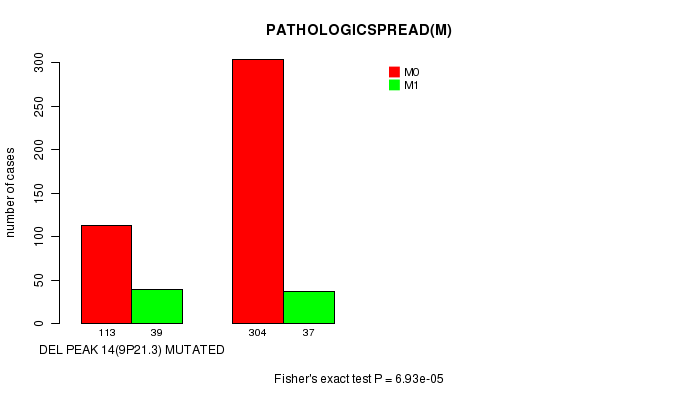
P value = 3.39e-08 (Fisher's exact test), Q value = 8e-06
Table S44. Clustering Approach #26: 'Del Peak 14(9p21.3) mutation analysis' versus Clinical Feature #8: 'TUMOR.STAGE'
| nPatients | I | II | III | IV |
|---|---|---|---|---|
| ALL | 238 | 52 | 123 | 80 |
| DEL PEAK 14(9P21.3) MUTATED | 49 | 10 | 52 | 41 |
| DEL PEAK 14(9P21.3) WILD-TYPE | 189 | 42 | 71 | 39 |
Figure S18. Get High-res Image Clustering Approach #26: 'Del Peak 14(9p21.3) mutation analysis' versus Clinical Feature #8: 'TUMOR.STAGE'
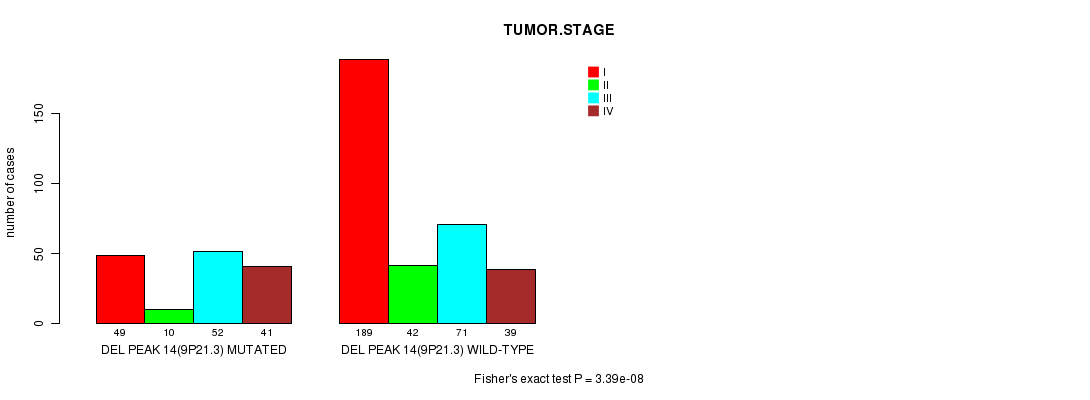
Table S45. Description of clustering approach #27: 'Del Peak 15(10q23.31) mutation analysis'
| Cluster Labels | DEL PEAK 15(10Q23.31) MUTATED | DEL PEAK 15(10Q23.31) WILD-TYPE |
|---|---|---|
| Number of samples | 90 | 403 |
P value = 0.000477 (Fisher's exact test), Q value = 0.1
Table S46. Clustering Approach #27: 'Del Peak 15(10q23.31) mutation analysis' versus Clinical Feature #5: 'PATHOLOGY.T'
| nPatients | T1 | T2 | T3 | T4 |
|---|---|---|---|---|
| ALL | 242 | 64 | 176 | 11 |
| DEL PEAK 15(10Q23.31) MUTATED | 31 | 10 | 43 | 6 |
| DEL PEAK 15(10Q23.31) WILD-TYPE | 211 | 54 | 133 | 5 |
Figure S19. Get High-res Image Clustering Approach #27: 'Del Peak 15(10q23.31) mutation analysis' versus Clinical Feature #5: 'PATHOLOGY.T'
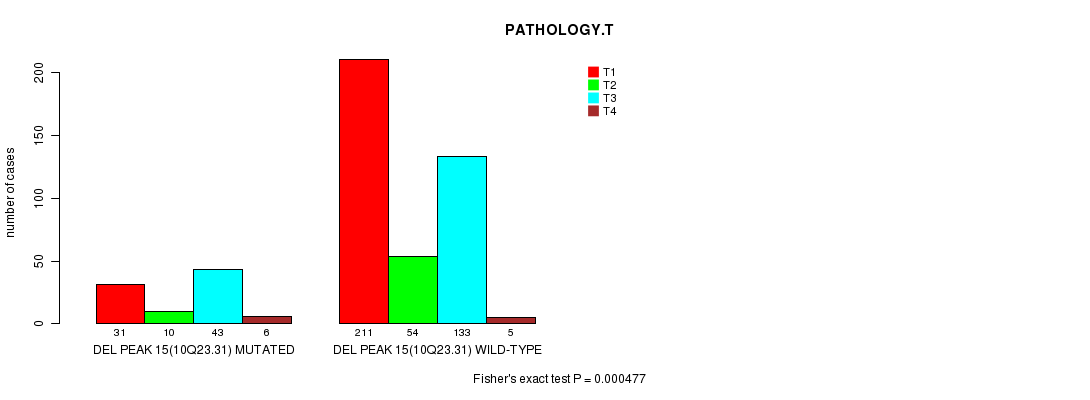
Table S47. Description of clustering approach #28: 'Del Peak 16(13q13.3) mutation analysis'
| Cluster Labels | DEL PEAK 16(13Q13.3) MUTATED | DEL PEAK 16(13Q13.3) WILD-TYPE |
|---|---|---|
| Number of samples | 76 | 417 |
P value = 0.000848 (logrank test), Q value = 0.18
Table S48. Clustering Approach #28: 'Del Peak 16(13q13.3) mutation analysis' versus Clinical Feature #1: 'Time to Death'
| nPatients | nDeath | Duration Range (Median), Month | |
|---|---|---|---|
| ALL | 490 | 158 | 0.1 - 111.0 (35.2) |
| DEL PEAK 16(13Q13.3) MUTATED | 75 | 34 | 0.1 - 89.4 (28.5) |
| DEL PEAK 16(13Q13.3) WILD-TYPE | 415 | 124 | 0.1 - 111.0 (36.3) |
Figure S20. Get High-res Image Clustering Approach #28: 'Del Peak 16(13q13.3) mutation analysis' versus Clinical Feature #1: 'Time to Death'
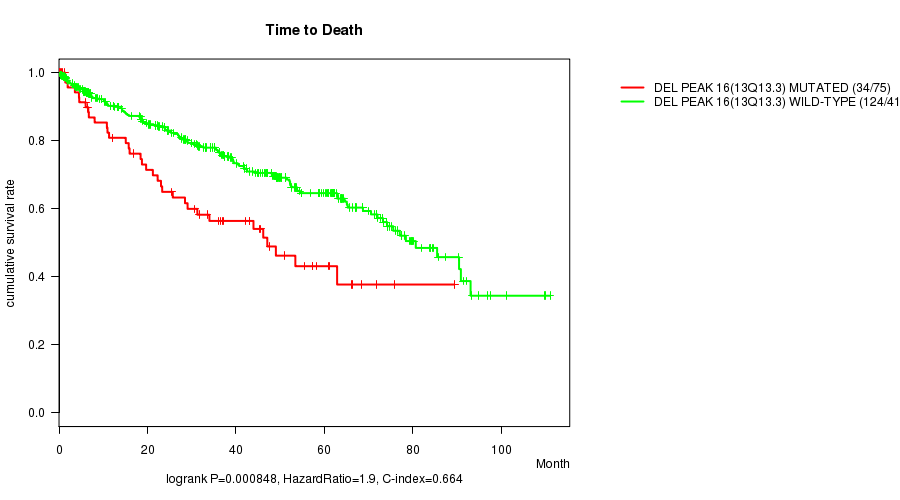
P value = 1.48e-05 (Fisher's exact test), Q value = 0.0034
Table S49. Clustering Approach #28: 'Del Peak 16(13q13.3) mutation analysis' versus Clinical Feature #5: 'PATHOLOGY.T'
| nPatients | T1 | T2 | T3 | T4 |
|---|---|---|---|---|
| ALL | 242 | 64 | 176 | 11 |
| DEL PEAK 16(13Q13.3) MUTATED | 28 | 3 | 39 | 6 |
| DEL PEAK 16(13Q13.3) WILD-TYPE | 214 | 61 | 137 | 5 |
Figure S21. Get High-res Image Clustering Approach #28: 'Del Peak 16(13q13.3) mutation analysis' versus Clinical Feature #5: 'PATHOLOGY.T'
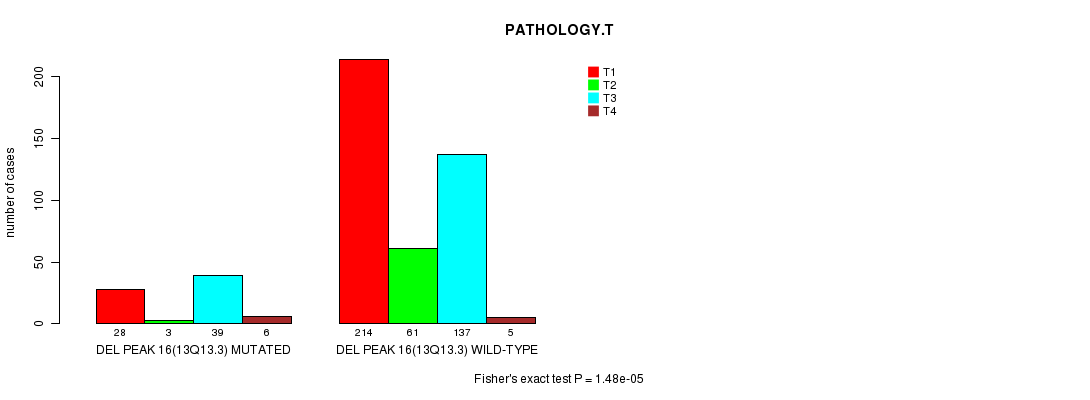
P value = 0.000348 (Fisher's exact test), Q value = 0.076
Table S50. Clustering Approach #28: 'Del Peak 16(13q13.3) mutation analysis' versus Clinical Feature #8: 'TUMOR.STAGE'
| nPatients | I | II | III | IV |
|---|---|---|---|---|
| ALL | 238 | 52 | 123 | 80 |
| DEL PEAK 16(13Q13.3) MUTATED | 27 | 2 | 27 | 20 |
| DEL PEAK 16(13Q13.3) WILD-TYPE | 211 | 50 | 96 | 60 |
Figure S22. Get High-res Image Clustering Approach #28: 'Del Peak 16(13q13.3) mutation analysis' versus Clinical Feature #8: 'TUMOR.STAGE'

Table S51. Description of clustering approach #29: 'Del Peak 17(14q31.1) mutation analysis'
| Cluster Labels | DEL PEAK 17(14Q31.1) MUTATED | DEL PEAK 17(14Q31.1) WILD-TYPE |
|---|---|---|
| Number of samples | 218 | 275 |
P value = 0.000107 (Fisher's exact test), Q value = 0.024
Table S52. Clustering Approach #29: 'Del Peak 17(14q31.1) mutation analysis' versus Clinical Feature #5: 'PATHOLOGY.T'
| nPatients | T1 | T2 | T3 | T4 |
|---|---|---|---|---|
| ALL | 242 | 64 | 176 | 11 |
| DEL PEAK 17(14Q31.1) MUTATED | 83 | 35 | 96 | 4 |
| DEL PEAK 17(14Q31.1) WILD-TYPE | 159 | 29 | 80 | 7 |
Figure S23. Get High-res Image Clustering Approach #29: 'Del Peak 17(14q31.1) mutation analysis' versus Clinical Feature #5: 'PATHOLOGY.T'
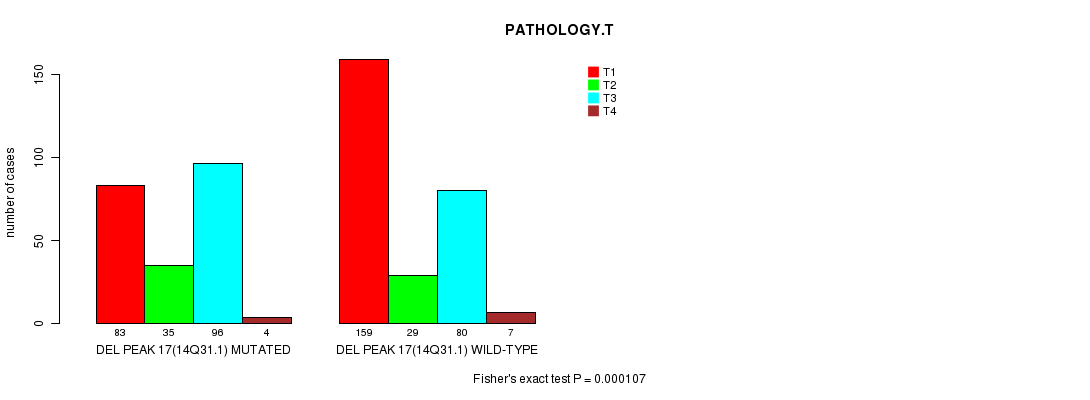
P value = 0.000113 (Fisher's exact test), Q value = 0.025
Table S53. Clustering Approach #29: 'Del Peak 17(14q31.1) mutation analysis' versus Clinical Feature #6: 'PATHOLOGY.N'
| nPatients | 0 | 1 |
|---|---|---|
| ALL | 228 | 18 |
| DEL PEAK 17(14Q31.1) MUTATED | 96 | 16 |
| DEL PEAK 17(14Q31.1) WILD-TYPE | 132 | 2 |
Figure S24. Get High-res Image Clustering Approach #29: 'Del Peak 17(14q31.1) mutation analysis' versus Clinical Feature #6: 'PATHOLOGY.N'

P value = 0.00101 (Fisher's exact test), Q value = 0.22
Table S54. Clustering Approach #29: 'Del Peak 17(14q31.1) mutation analysis' versus Clinical Feature #7: 'PATHOLOGICSPREAD(M)'
| nPatients | M0 | M1 |
|---|---|---|
| ALL | 417 | 76 |
| DEL PEAK 17(14Q31.1) MUTATED | 171 | 47 |
| DEL PEAK 17(14Q31.1) WILD-TYPE | 246 | 29 |
Figure S25. Get High-res Image Clustering Approach #29: 'Del Peak 17(14q31.1) mutation analysis' versus Clinical Feature #7: 'PATHOLOGICSPREAD(M)'

P value = 2.42e-05 (Fisher's exact test), Q value = 0.0055
Table S55. Clustering Approach #29: 'Del Peak 17(14q31.1) mutation analysis' versus Clinical Feature #8: 'TUMOR.STAGE'
| nPatients | I | II | III | IV |
|---|---|---|---|---|
| ALL | 238 | 52 | 123 | 80 |
| DEL PEAK 17(14Q31.1) MUTATED | 79 | 25 | 68 | 46 |
| DEL PEAK 17(14Q31.1) WILD-TYPE | 159 | 27 | 55 | 34 |
Figure S26. Get High-res Image Clustering Approach #29: 'Del Peak 17(14q31.1) mutation analysis' versus Clinical Feature #8: 'TUMOR.STAGE'
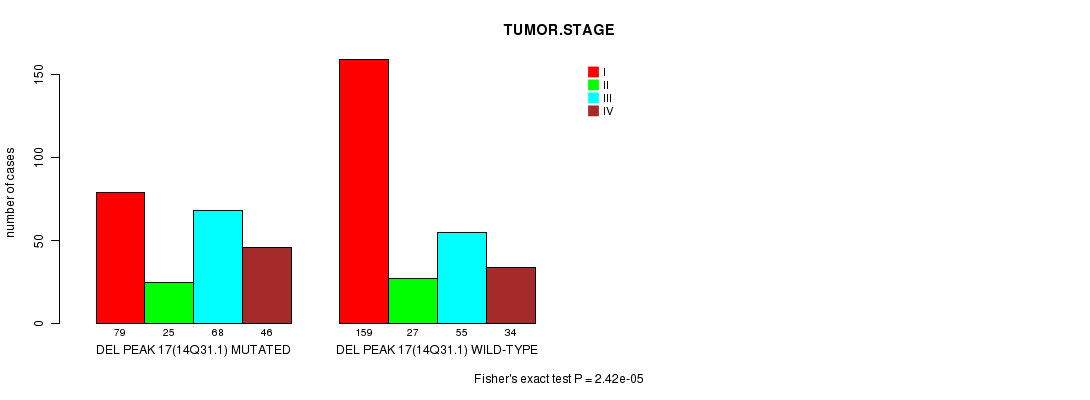
Table S56. Description of clustering approach #30: 'Del Peak 18(Xq23) mutation analysis'
| Cluster Labels | DEL PEAK 18(XQ23) MUTATED | DEL PEAK 18(XQ23) WILD-TYPE |
|---|---|---|
| Number of samples | 55 | 438 |
-
Cluster data file = all_lesions.conf_99.cnv.cluster.txt
-
Clinical data file = KIRC-TP.clin.merged.picked.txt
-
Number of patients = 493
-
Number of clustering approaches = 30
-
Number of selected clinical features = 8
-
Exclude small clusters that include fewer than K patients, K = 3
For survival clinical features, the Kaplan-Meier survival curves of tumors with and without gene mutations were plotted and the statistical significance P values were estimated by logrank test (Bland and Altman 2004) using the 'survdiff' function in R
For continuous numerical clinical features, two-tailed Student's t test with unequal variance (Lehmann and Romano 2005) was applied to compare the clinical values between two tumor subtypes using 't.test' function in R
For binary clinical features, two-tailed Fisher's exact tests (Fisher 1922) were used to estimate the P values using the 'fisher.test' function in R
For multiple hypothesis correction, Q value is the False Discovery Rate (FDR) analogue of the P value (Benjamini and Hochberg 1995), defined as the minimum FDR at which the test may be called significant. We used the 'Benjamini and Hochberg' method of 'p.adjust' function in R to convert P values into Q values.
This is an experimental feature. The full results of the analysis summarized in this report can be downloaded from the TCGA Data Coordination Center.